

| Help in identifying Steatoda nobilis - the Noble False Widow | ||
| ...... |
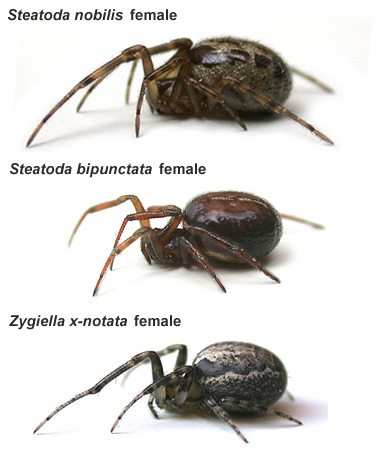 |
With the news that the
UK's most well known spider had at long last reached
Nottinghamshire in back in September 2016, we thought that it
would be useful to provide a basic identification guide
to Steatoda nobilis - the infamous Noble False
Widow. Hopefully, it should deter the general public from needlessly killing any spider suspected as being Steatoda nobilis in a blind panic after all that has been (and unfortunately continues to be) incorrectly reported in those tabloid newspapers not worth the paper they're printed on. Incorrect and ridiculously sensationalist reporting has done Steatoda nobilis no favours and to be honest, neither has the grossly exaggerated over-reaction of a proportion of the general public. Even with a phobia of spiders, there is no plausible need to kill any UK spider. Only a handful of UK species have jaws that are developed enough, or are large enough to pierce human skin. The majority of the public will never come across any of these spiders and although some do occur in and around UK houses and other buildings, you have to deliberately go looking for them. There are no outwardly aggressive UK spiders regardless of what the media claim. As with Bee and Wasp stings, spider bites are always the result of human interference one way or another - either accidentally or purposefully. They do not come looking for you, nor are any of our spiders really venomous. Proven Steatoda (False Widow) bites have been described as being similar to the sting from a Bee or Wasp. |
|
| ...... | ||
| The vast majority of bite reports in the media are completely unverified and 99% are not even spider related. Although Steatoda nobilis can bite if provoked, it is extremely unlikely ever to do so, as its habits are retiring and non-confrontational. Thanks to incorrect reporting and sensationalising claims by the media, this Spider now has a totally unwarranted reputation with the public. Some of the public's panic and fear so wrongly associated with Steatoda nobilis, may stem from the 'False Widow' part of the common name - Widow itself obviously being derived from the notorious 'Black Widow' (Latrodectus sp) which does not occur in the UK, in a wild state. | ||
| ...... | ||
Known Nottinghamshire records Steatoda nobilis has been in the UK since for well over a century and is abundant in many parts of southern England. In recent years, there has been a gradual northwards spread but records from most Midlands counties are still unusual. Although it does not habitually occur indoors, it may be found tucked away in garages, sheds and conservatories. It certainly does not lurk (as is sometimes reported in the press) in peoples clothing or beds. False Widow bites claimed by people sleeping in beds are utter nonsense, made even more nonsensical by the claim of seeing a 'small spider' in the vicinity. Adult Steatoda nobilis are quite large spiders. This is a spider usually found around the outside of buildings and houses, where it builds a substantial 'scaffold' web (shown above) with a tubular retreat partially hidden within a crack or crevice. The web differs from other Steatoda species on the strength of its silk, being noticeably stronger. |
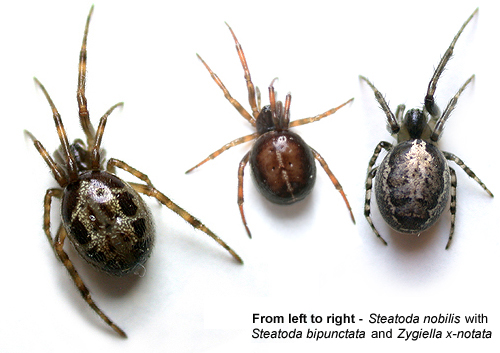 |
|
| ...... | ||
| It is likely that Steatoda nobilis has been present in the county for a several years, having gone unrecorded here for a number of years. To date (October 2019) the spider has still only been confirmed from a small number of Nottinghamshire sites - two being garden centres. Nottinghamshire's first record was was discovered during a public Bat walk, found under an interpretation panel at the Nottinghamshire Wildlife Trust's Attenborough Nature Reserve on September 17th 2016, by assistant reserve manager Tim Sexton. Around two weeks later, we found examples of both sexes at the Dukeries Garden Centre near Worksop on September 30th 2016, where it was present in good numbers on the basis of the number of webs located. Other (confirmed) records have since come from two sites at Mapperley (including Brookfield's Garden Centre) Newark and Retford, so is obviously much more widespread than we had previously thought. | ||
| ...... |
| Identification If you have already killed your suspected Steatoda nobilis (Noble False Widow) then there's little point in carrying on any further. As we have already pointed out, there is absolutely no need to kill any spider found in a Nottinghamshire house - no matter how big your fear. Spiders can be safely caught in a glass or jar and released unharmed outside. Even if you do indeed find a False Widow around your house, chances are that you've lived with them for a number of years and they've not bitten the kids have they? We are only providing photographic comparisons to help people determine the three species dealt with here. Remember that Steatoda nobilis is still rarely reported in many Midland counties and despite being on the increase, it is unlikely to be common throughout Nottinghamshire yet. |
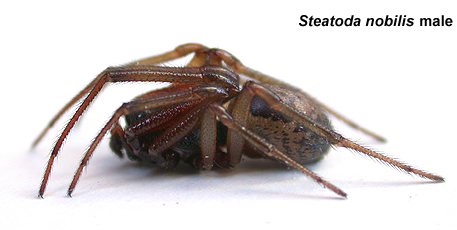 |
|
| ...... | ||
| None of the three spiders will be found on vegetation away from houses or fences and if the spider you think may be Steatoda nobilis has constructed an orb web, then it isn't Steatoda nobilis. The photographs below show typical orb web of Zygiella x-notata (left) compared to the 'scaffold' web produced by Steatoda nobilis (right). The Steatoda nobilis web is constructed of extremely strong silk, which was an initial clue towards us suspecting the identity of the web's occupant. |
| ...... | ||
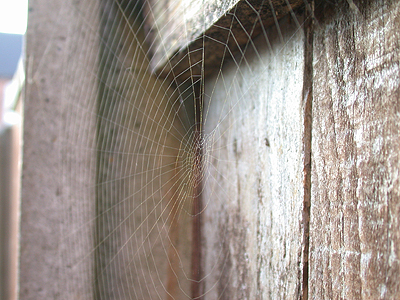 |
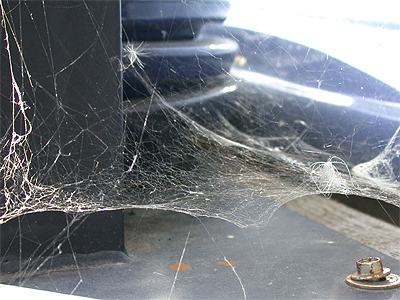 |
|
| ...... | ||
| The most
common spider to be found around houses is Zygiella
x-notata, which (like it or not) is somewhere around
the outside of every single house in Nottinghamshire and
completely harmless. An orb weaver, it constructs its
medium-sized web on door and window frames where during the daytime, it
sits in its retreat, usually positioned in the corner of the frame, but also
constructs its web along fences and walls etc. It is not usually found on
garden shrubs, but will construct its web on Ivy or other
wall growing plants. Learn to recognise Zygiella x-notata, as this is the spider which will inevitably be seen or found first. It remains active throughout the year and can often be found in its web on Winter evenings when the temperature is well below 0°C. Steatoda nobilis and Steatoda bipunctata are both generally less obvious species and only active at night. They both spin 'scaffold' webs with a tubular retreat running into a crevice and will drop out of their webs when disturbed. Allow for variations in the abdominal markings of both species. |
||
| Steatoda nobilis (Thorell, 1875) |
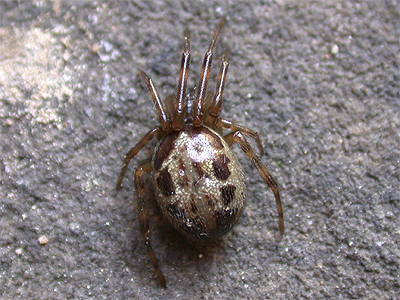 |
UK
and Nottinghamshire range .. Formerly restricted to southern
counties of the UK, Steatoda nobilis is now well
established in the Thames area, with evidence of
northwards range expansion into the Midlands and has been
one of the commonest spiders in urban areas along the
south coast for many years. The fact that there have been
only a handful of (accurately identified) cases of this
spider biting humans, is testament to its non-aggressive
nature. Habitat .. Usually found around the outside of buildings and houses (rarely indoors), where it builds a substantial 'scaffold' web with a tubular retreat partially hidden within a crack or crevice. The web differs from other Steatoda species on the strength of its silk, being noticeably stronger. Identification .. Adult Steatoda nobilis is significantly larger than both Steatoda bipunctata and Zygiella x-notata. Abdominal markings vary and are usually clearer and more pronounced on males. Mature females often lack any abdominal markings. The leg colour of the male is distinctively reddish to pale yellow. |
|
| Steatoda bipunctata (Linnaeus, 1758) |
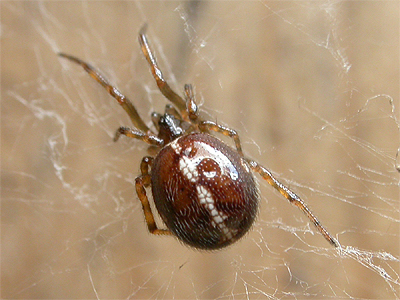 |
UK
and Nottinghamshire range .. Widespread across the UK and
throughout Nottinghamshire. No doubt present around every house and garden in the
county, Steatoda bipunctata is not a regularly seen spider. Habitat .. Active at night, this spider favours the quiet corners of sheds, out-buildings and cracks along fences and walls etc, where it constructs a typical 'scaffold' web. It is often found in hutches and poultry sheds and sometimes commonly referred to as the Rabbit Hutch Spider. Identification .. Much smaller than Steatoda nobilis, the abdomen is an attractive, rich chestnut brown colour. There is usually a whitish line or band running dorsally along the length of the abdomen, coupled with a white line/band running around it laterally. The strength and clarity of these markings can vary with the age of the individual spider and some older specimens can appear unmarked and very dark. |
|
| Zygiella x-notata (Clerck, 1757) |
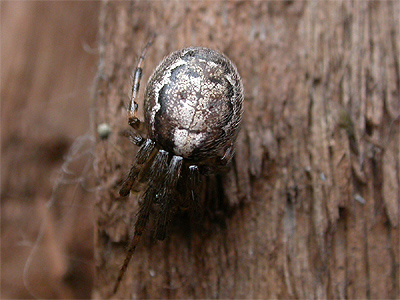 |
UK
and Nottinghamshire range .. A widespread spider in the UK,
found broadly across Nottinghamshire. There is probably
no house or building in the county where this spider
isn't present. Habitat .. Zygiella x-notata spins a medium sized orb web on door or window frames etc, but also on outbuildings, sheds, fences and walls. Occasionally found indoors along the join of wall and ceiling, especially in kitchens and bathrooms, where windows are often open for long periods. Females remain active throughout the year, even when temperatures drop below 0°C. Identification .. The fact that Zygiella x-notata spins an orb web, should immediately rule out both Steatoda species, but this spider is still the most likely to be mis-identified and wrongly mistaken for Steatoda nobilis, despite being much smaller. As it is so common, familiarisation of the abdominal markings is easy and should be learned. |
|